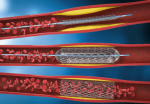Lesions in the left main coronary artery (LMCA) continue to pose a significant challenge. The use of coronary imaging before percutaneous coronary implantation (PCI) has proven useful in analyzing the lesion, identifying the presence and location of calcification, and determining lesion length in the LMCA, the left anterior descending artery, and the circumflex artery. Various...
TAVR in Asymptomatic or Minimally Symptomatic Patients: 30-Day Results
Aortic valve replacement (AVR) is recommended for symptomatic aortic stenosis (AS), while close monitoring is the advised strategy for asymptomatic patients, unless they have elevated aortic gradients, reduced ejection fraction, or abnormal stress tests. However, the optimal timing for AVR remains uncertain, especially in light of recent evidence suggesting that AS patients showing signs of...
Treatment and Gender-Based Outcomes for Coronary Bifurcation Stent Placement: Report from the e-ULTIMASTER Registry
Approximately 20% of all percutaneous coronary interventions (PCI) are performed on bifurcation lesions, which continue to pose a challenge in terms of strategy: how many stents to use, what is the most suitable strategy, and when to transition from a single stent to two during the procedure. Additionally, the use of two stents in these...
MITRAL Trial, Results at 5 Years
Repeat mitral valve repair has been associated with increased mortality. Transcatheter mitral valve repair has surged as an alternative for patients treated with mitral valve-in-valve (MViV), valve-in-ring (MViR), or valve-in-mitral for annular calcification (ViMAC). Current data from the VIVID and the MAC Global Registry on 30-day evolution in these 3 scenarios show 7.4%, 11.4% and...
TriClip: Good Outcomes After a 2-Year Follow-up
Severe tricuspid regurgitation (TR) is an underestimated condition in healthcare systems. However, it is more common than believed, especially in individuals over 65 years of age. This condition is linked to hospitalizations due to heart failure, mortality rates, and a progressive decline in quality of life. Surgery to treat TR on its own is complicated,...
AMI and Multivessel Disease: Can We Perform a Single Procedure?
Percutaneous coronary intervention (PCI) is considered the treatment of choice in ST-segment elevation myocardial infarction (STEMI). However, it is widely acknowledged that, in many cases, there are significant lesions in other coronary arteries. Previous randomized studies have shown that complete revascularization in a second procedure is more beneficial than intervention only in the culprit artery....
TRILUMINATE Two Years In: Encouraging Results
Tricuspid valve regurgitation is more common than one might think. It often stems from left valve disease and associated with increased mortality and hospitalization due to heart failure, which is not easy to treat. Currently, guidelines list surgery as the recommended treatment, though this option is quite complex and might entail complications and mortality risk....
Is Complete Revascularization Really Necessary after AMI in the Elderly?
The population over 75 is growing gradually, which entails an increase in acute myocardial infarction (AMI) in this group. As we all know, it is fairly common for AMI to present with multivessel disease. It has been shown that younger patients will benefit from complete revascularization vs. a simple resolution of the culprit vessel. However,...
OCT-Guided PCTA: Does It Offer any Benefits?
For many years, percutaneous transluminal coronary angioplasty (PCTA) has expanded significantly worldwide. However, despite the demonstrated advantages of intravascular ultrasound (IVUS) in terms of minimal luminal area, reduced cardiovascular events, and restenosis, its use is not very common due to various reasons. On the other hand, optical coherence tomography (OCT) offers even higher resolution than...
What to Do in Cases of AMI with Multivessel Disease
The presence of lesions in multiple vessels is common in ST-segment elevation myocardial infarction (STEMI). It has been shown that, when they are treated in a second procedure, patients have a better outcome. To date, there is limited information available on percutaneous transluminal coronary angioplasty (PTCA) in vessels with severe non-culprit lesions during primary angioplasty....








